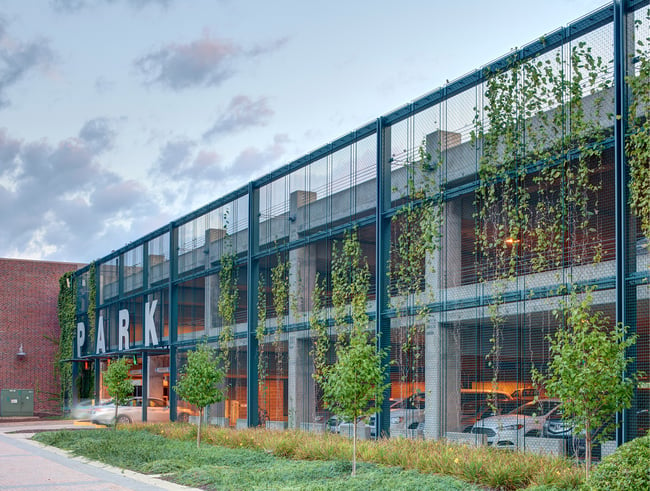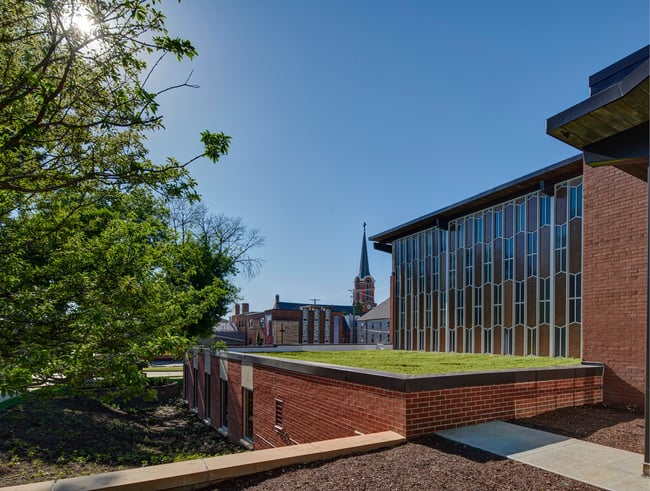Mitigating Urban Heat Islands Through Building and Site Design

According to the US Census Bureau, nearly 80% of the US population lives in an urban area. These populations are more vulnerable to the effects of climate change, with high concentrations of roads and buildings exasperating summer heat waves.
Increased temperatures in cities are known as urban heat islands. On warm days, materials like concrete and asphalt radiate heat, increasing the temperature of the surrounding areas.
Mitigating urban heat islands has become a priority for many cities across the country, and building and landscape design can help. This article will discuss a few of the strategies design teams can use to minimize heat gains and promote healthier, safer urban areas.
Understanding Urban Heat Islands
The urban heat island effect refers to higher temperatures in urban areas caused by a high concentration of building materials.
All materials have an emissivity rating—their ability to radiate heat. Common materials like concrete, brick, and asphalt have high emissivity ratings, leading to increased temperatures during summer months. As a result, urban areas can experience temperatures several degrees warmer than vegetated areas.
While heat islands are a city-wide issue, they can impact some neighborhoods more than others. Areas lacking green space and sufficient tree coverage will experience higher temperatures than other areas of a city. Often, areas with less green spaces are also the most historically disadvantaged.
Beyond neighborhoods, the effects can be even more localized. High concentrations of concrete around mechanical systems can make it difficult to cool the air, leading to inefficiencies and increased costs. Similarly, asphalt parking lots can increase temperatures surrounding shopping centers.
As extreme temperatures become more common, urban heat islands pose human health risks. Vulnerable populations—especially those living without air conditioning—are at a greater risk for hospitalizations and heat-related deaths.
Strategies for Mitigating Urban Heat Islands
While most efforts to curb urban heat islands occur at the city level, thoughtful building and site design can help. Specific approaches differ depending on the location and climate, but a few general rules apply in most areas.
Increasing Vegetation
Increasing vegetation is the most effective way to curb heat islands. Street-side tree plantings can shade pavement and prevent heating. Trees also absorb water through their roots and release it through their leaves, cooling the surrounding area.
Although trees are the most effective approach, any vegetation is better than hardscapes. Designers should find ways to integrate green spaces into building sites to reduce temperatures and create recreational opportunities for occupants.

Replacing hardscape with vegetation can reduce excess heat.
In dense areas, green spaces can be hard to achieve. Green roofs, however, can help moderate daytime temperatures. One study finds that green roof temperatures can be 30-40 degrees Fahrenheit lower than conventional roofing systems. This approach can also help rooftop mechanical systems operate more efficiently, lowering operating costs.
Increased vegetation offers additional benefits, often called “sustainable synergies” by designers and environmentalists. Trees can help reduce greenhouse gas emissions, improve a neighborhood’s aesthetic value, and provide wildlife habitats. Additionally, increased vegetation and green spaces can aid stormwater management and improve municipal water quality by naturally filtering rainfall.

Green roofs can moderate daytime temperatures.
For maximum impact, municipal efforts should focus on the areas of greatest need. In the Iowa City-Cedar Rapids area, tree planting programs are using heat mapping to focus their efforts. Such programs can help cool the neighborhoods impacted most directly by summer heat waves.
Selecting Materials with Lower Emissivity Ratings
While increasing vegetation, designers can prioritize materials with lower emissivity ratings. The more a material radiates heat, the more likely it is to contribute to heat islands.
For example, clean concrete pavement has a slightly lower emissivity rating than asphalt, making it a better option for pavement. Similarly, lighter-colored roofing systems have lower ratings than traditional black tar roofs.
Design teams should balance emissivity ratings with other design considerations. While white roofs may have lower emissivity ratings, they can cause glare issues on sunny days. For a better understanding of emissivity, explore this table of common building materials.
Why Consider Heat Islands?
When starting a building project, heat islands are not at the top of everyone’s minds. Although we all experience the negative effects of heat islands, we do not always consider how individual building sites contribute.
The built environment affects everyone in a city, and we all have a responsibility to our neighbors. Increasing vegetation and prioritizing materials with lower emissivity rates help curb a city-wide issue, making your community safer and more resilient to climate change.
These strategies also help regulate thermal comfort, create a more pleasant occupant experience, and improve the efficiency of your cooling system. These tactics should be thought of as one component of a larger strategy to improve building performance and lower operating costs.
Learn More About Sustainable Design
As climate change makes heat waves more frequent, mitigating urban heat islands will become a priority for many cities. While city-wide tree planting efforts are one of the most effective solutions, individual building sites can help.
Strategies like increasing street-side plantings, adding greenspaces and green roofs, and selecting materials with lower emissivity levels can help cool the surrounding area. At the same time, these practices benefit occupants and improve building efficiency.
One recent project to implement these strategies was the Stanley Center for Peace and Security. As a part of the Living Building Challenge (LBC), the owners added street-side tree plantings and bioretention cells with native plantings. Learn more by reading about the LBC’s Place Petal.